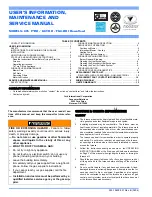
20
20
Gas Supply and Piping
High Altitude Derate
When this furnace is installed at high altitude, the appropriate High Altitude orifice kit must be applied. This is required due
to the natural reduction in the density of both the gas fuel and combustion air as altitude increases. The kit will provide
the proper design certified input rate within the specified altitude range.
High altitude kits are purchased according to the installation altitude and usage of either natural or propane gas. Refer
to the product Specification Sheet for a tabular listing of appropriate altitude ranges and corresponding manufacturer’s high
altitude (natural, propane gas, and/or pressure switch) kits.
Do
not
derate the furnace by adjusting the manifold pressure to a lower pressure than specified on the furnace rating plate.
The combination of the lower air density and a lower manifold pressure will prohibit the burner orifice from drawing the
proper amount of air into the burner. This may cause incomplete combustion, flashback, and possible yellow tipping.
In some areas the gas supplier may artificially derate the gas in an effort to compensate for the effects of altitude. If the
gas is artificially derated, the appropriate orifice size must be determined based upon the BTU/ft
3
content of the derated
gas and the altitude. Refer to the National Fuel Gas Code, NFPA 54/ANSI Z223.1, and information provided by the gas
supplier to determine the proper orifice size.
A different pressure switch may be required at high altitude regardless of the BTU/ft
3
content of the fuel used. Refer to the
product Specification Sheet for a tabular listing of appropriate altitude ranges and corresponding manufacturer’s pressure
switch kits.
Gas Piping Connections
The gas piping supplying the furnace must be properly sized based on the gas flow required, specific gravity of the gas,
and length of the run. The gas line installation must comply with local codes, or in their absence, with the latest edition
of the National Fuel Gas Code, NFPA 54/ANSI Z223.1.
To connect the furnace to the building’s gas piping, the installer must supply a ground joint union, drip leg, manual shutoff
valve, and line and fittings to connect to gas valve. In some cases, the installer may also need to supply a transition piece
from 1/2" pipe to a larger pipe size.
``
Location of Manual Valve
(Installed Ahead of Ground
Joint Pipe Union)
Height Required
By Local Code
Ground Joint Pipe Union
To Be Installed Ahead Of
Gas Valve
Drip Leg
Reducing Coupling
1/2" x 1/8" with 1/8"
Pipe Plug To Measure
Line Gas Pressure
Gas Piping Connections
The following rules apply when installing piping:
1. Use black iron or steel pipe and fittings for the build-
ing piping.
2. Use pipe joint compound on male threads only. Pipe
joint compound must be resistant to the action of the
fuel used.
3. Use ground joint unions.
4. Install a drip leg to trap dirt and moisture before it
can enter the gas valve. The drip leg must be a mini-
mum of three inches long.
5. Install 1/8” NPT pipe plug fitting, accessible for test
gage connection, upstream of the gas supply con-
nection to the furnace.
6. Use two pipe wrenches when making connection to
the gas valve to keep it from turning. Maintain factory
shipped orientation.
7. Install a manual shutoff valve in a convenient loca-
tion between the meter and the unit within six feet of
unit. Any union installed, must be downstream of the
manual shutoff valve and located between the shut-
off valve and furnace.
8. Tighten all joints securely.
















































